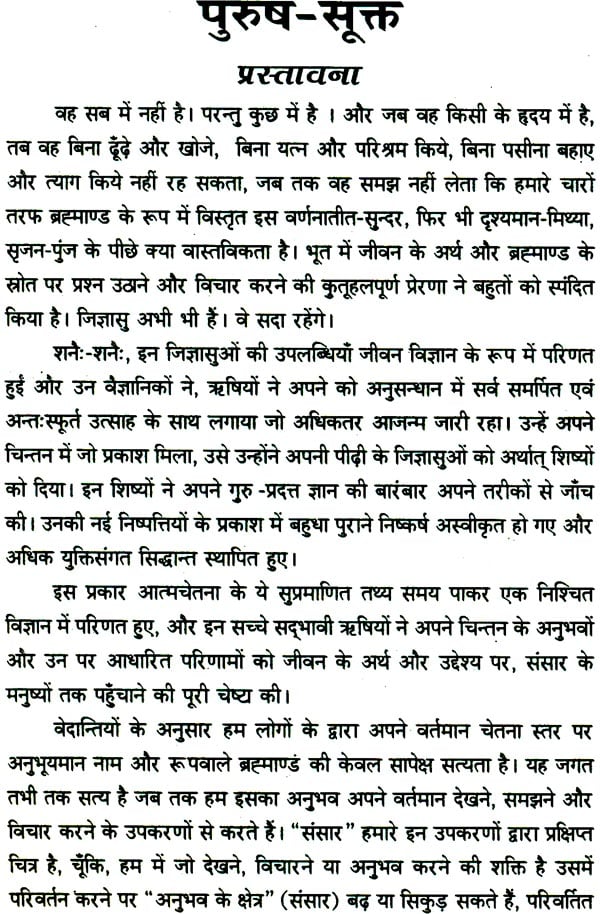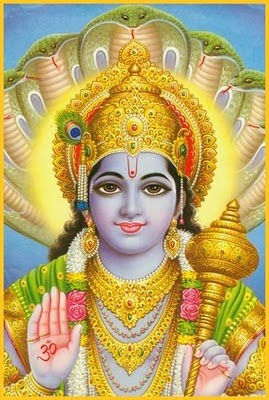THEPURUSHASUKTA
Oct 09, 2014 purusha suktam sanskrit Shlok Meaning in English - The Perfect Being has thousand (unlimited) heads, thousand (unlimited) eyes, and thousand (unlimited) feet. Having pervaded the whole earth. The Purusha Suktam is one of the Pancha Suktams of the Sri Vaishnava sampradaya or tradition. The other four are the Narayana Suktam, Sri Suktam, Bhu Suktam, and the Nila Suktam. The Purusha Suktam is seen earliest in the Rg Veda.
The Vedic Hymn on the Supreme Being
by Sri V. Sundar
February 17, 1995
Contents


- General Introduction
- Introduction to the Purusha Sukta
- First anuvAka
- Second anuvAka
Invocation to the Acharyas
That wondrous lineage of preceptors, that starts with Sriman Narayana,
and came through Nathamuni down to my own Acharya, I salute that.
Invocation to Vishvaksena (sEnai mudaliAr)
An Introduction to the Purusha Sukta

Where is the Purusha Suktam in the Vedas?
Hindu religious sources are classified as ``Sruti' or``smRti'. Sruti -- that which is heard -- is of the nature of divine revelation. We believe that the Vedas, hymns composed by seers and sages beginning as best as we candate them in 3000 BC, were sung under divine inspiration.This is why they are Sruti. These sages ``heard' themas the voice of the Divine.
Only two bodies of hymns are recognized as divinelycomposed. One being the Vedas, and the other, the Thiruvaaymozhi of Kaari Maaran Sadagopan, or Sri Nammaazhvaar,which are recognizedas equivalent to the 4 Vedas in the Ubhaya Vedanta school, the Sri Vaishnava tradition. The six compositions of Kaliyan Neelan, or Sri Thirumangai Aazhvaar, are recognized as the 6 vedAngas.
- [Note: ubhaya vedAnta refers to the twofold vedAnta,seen through the two eyes of the Sanskrit Upanishads andthe Tamil Divya Prabandham. They are of paramount and equal authority to Sri Vaishnavas.]
SmRti is that which is remembered, and includes a large part of the commentary of the Vedas, differentPuranas, epics, and other sources.
The Purusha Suktam is one of the Pancha Suktams of the Sri Vaishnava sampradaya or tradition. The other four are the Narayana Suktam, Sri Suktam, Bhu Suktam, and the Nila Suktam.
The Purusha Suktam is seen earliest in the Rg Veda,as the 90th Suktam of its 10th mandalam, with 16mantrams. Later, it is seen in the Vajasaneyi Samhitaof the Shukla Yajur Vedam, the Taittriya Aranyaka ofthe Krishna Yajur Vedam, the Sama Veda, and the Atharvana Veda, with some modifications and redactions.

In South India, the Purusha Suktam, Vishnu Suktam, Sri Suktam, and Narayana Suktam are generally chanted together in paarayanam.
The Sri Rudram, Purusha Suktam, Upanishads,the Gita, and the Vishnu Sahasra Naamam are alsorecommended for daily paarayanam - chanting.
Since the Purusha Suktam is seen in all Vedas,it is cited as the essence of all Srutis by VedaVyasa in the Mahabharata. Saunaka, Apastamba,and Bodhayana have also written concerning theuse of the Purusha Suktam.
What does the Purusha Suktam talk about?
The Purusha in the title of the Purusha Sukta refers to theParama Purusha, Purushottama, Narayana, inhis form as the ViraaT Purusha. He was the sourceof all creation. It describes this form of his, ashaving countless heads, eyes, legs, manifestedeverywhere, and beyond the scope of any limitedmethod of comprehension. All creation is but afourth part of him. The rest is unmanifested.
Purusha as Brahma remained inactive, andAniruddha Narayana, one of the four aspectsof Narayana in the first tier at the base of theVishaaka Yoopa, asked him ``Why do youdo nothing?' ``Because of not knowing,' Brahma replied. ``Perform a yajna. Yoursenses, the devas, shall be the ritviks. Yourbody shall be the havis. Your heart, the altar. And I shall be he who enjoys the havis -- theoffering. From your body sacrificed, shall you create bodies for all living creatures, as you havedone in kalpas before this.' Thus says the sAkalya brAmhaNA.
This yajna was called ``sarvahut', the offeringof all. The act of creation itself grew out of yajna,the rite of sacrifice. Who was worshipped at thissacrifice? It was the Purusha. Who performed it?Brahma, the creative aspect of the Purusha. Whowere the ritvik priests ? The devas, who are thePurusha's senses. Who was tied as the beast of the sacrifice? Brahma, again. What was barhis, the altar of the sacrifice? All of nature. Who was the fire? The Purusha's heart. What was sacrificed? Again, the Purusha himself, his great body that contained all ofcreation.
In a way, this is a message of love, that the Purushawould consume himself in the fire of creation, tocreate all the worlds. From this sacrifice did allof creation emanate. This is central to the messageof the Purusha Sukta.
This great Purusha, brilliant as the sun, who
is beyond all darkness, I know him in my
heart. Who knows the Purusha thus,
attains immortality in this very birth.
I know of no other way to salvation.
The redaction I have attempted to translate is based to alarge part on theistic tradition and approach, rather than a critical approach. This is because this is the waythis wonderful cosmogenical song speaks to me. Mysources for the translation are to put it mildly, a hodgepodge. I have little skill in Sanskrit myself, andhave had to borrow heavily from these sources:
Purusha Suktam Sanskrit Pdf
Hopefully, that works. And now, on with the show!
Purusha Suktam Sanskrit Pdf
Purusha Suktam Sanskrit Pdf Free Download
Purusha Sukta:Purusha Suktam Sanskrit English
Back to the Sri Vaishnava Home Page